Milan Fashion Week Men’s S/S 2024: Prada to JW Anderson
The best of Milan Fashion Week Men’s S/S 2024 – from curtains of slime at Prada to a return to reality at JW Anderson
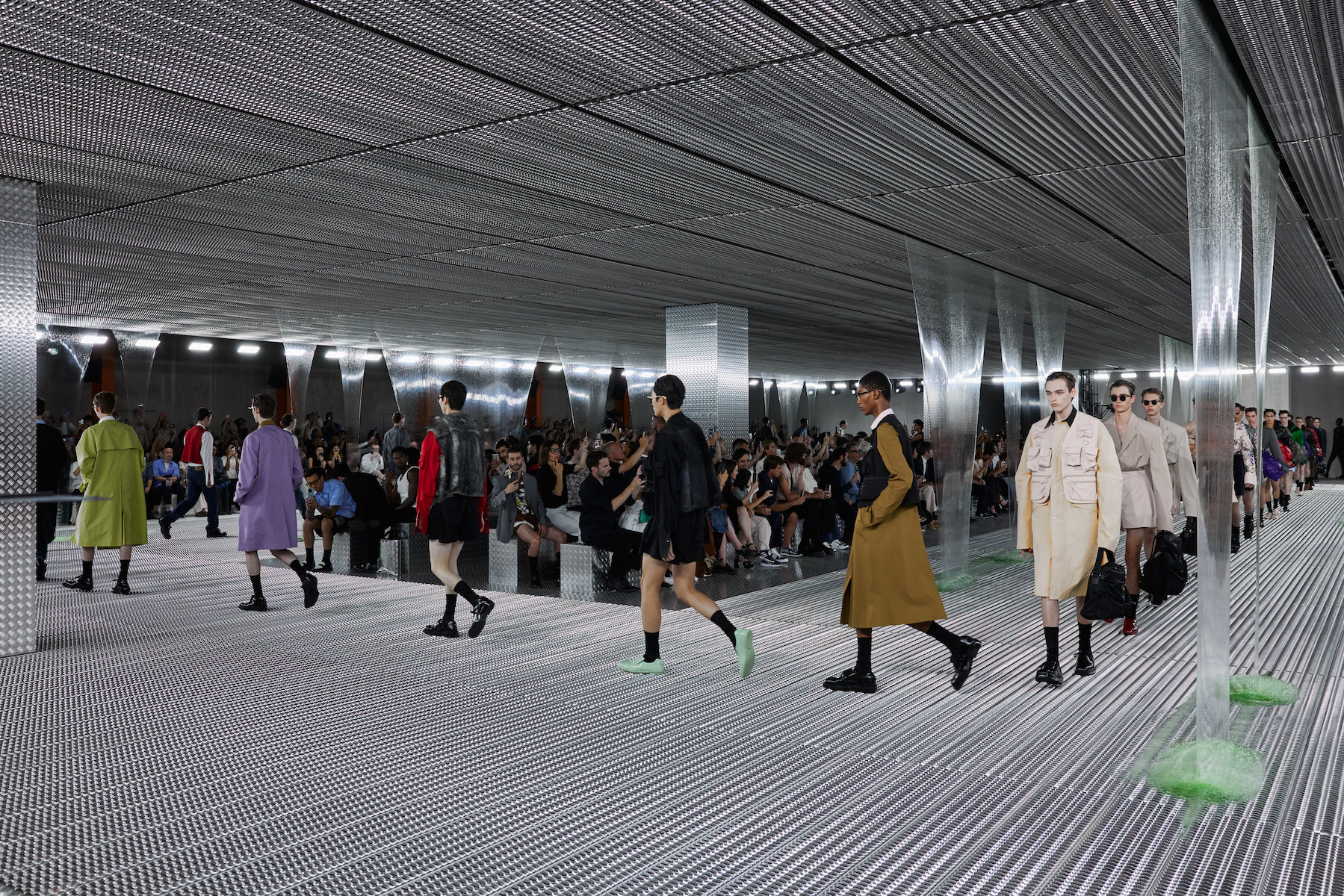
The menswear season rolled onwards to Milan Fashion Week S/S 2024 this past weekend as the Italian city played host to an eclectic amalgam of runway shows, presentations and openings. Among them, a dedicated menswear show from Valentino, which opened proceedings on the afternoon of 16 June. Titled ‘The Narratives’ and held at the Università degli Studi di Milano Statale, it saw the house divert from recent co-ed shows held in Paris – a tribute, said creative director Pierpaolo Piccioli, to house founder Valentino Garavani, who showed his first menswear collection in 1985 in Milan.
Elsewhere in the city, Ralph Lauren Purple Label made its return to the Milan Fashion Week schedule, while British labels JW Anderson and Charles Jeffrey Loverboy continued to choose the city to present their latest collections. Rounding out the week was the usual array of high-profile Italian houses, looking to define the menswear season ahead – among them Prada, Gucci, Dolce & Gabbana, Emporio Armani, Giorgio Armani, Tod’s, Missoni, and Zegna, which closed the week on the afternoon of 19 June.
Here is the very best of Milan Fashion Week Men’s S/S 2024 – from curtains of slime at Prada to a return to reality at JW Anderson.
The best of Milan Fashion Week Men’s S/S 2024
Zegna
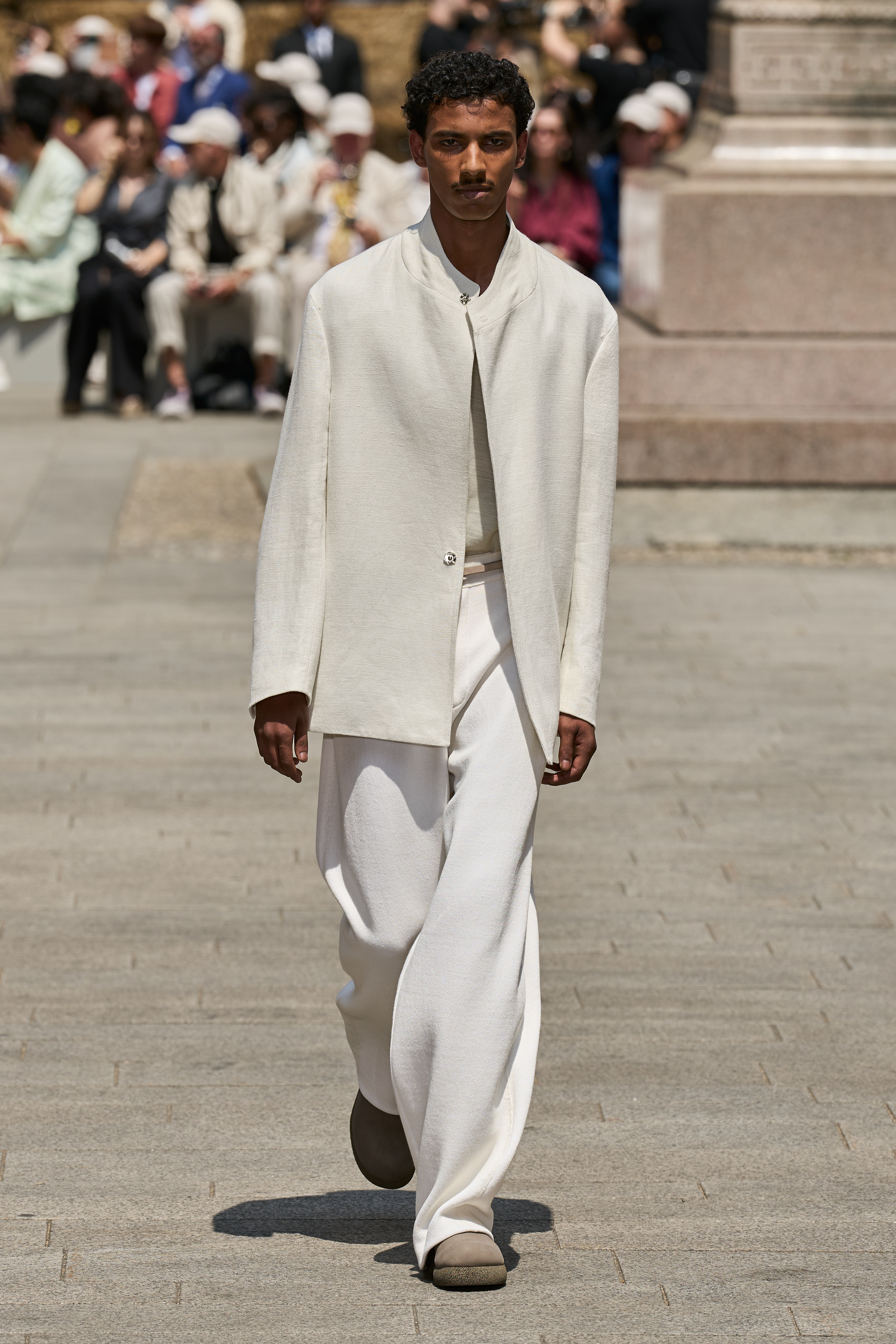
Zegna S/S 2024
Held in central Milan’s Piazza San Fedele – creative director Alessandro Sartori’s favourite square in the city – the sun-soaked outdoor runway was outlined with 192 enormous bales of raw linen flax. Not just a prop, the bales had been transported from Normandy; after the show they would go back onto the production line to create Zegna’s various linens at the house’s Italian factories. The show itself, titled ‘L'Oasi Di Lino’, was a celebration of the summertime fabric, selected for its feeling of lightness and fluidity and rendered in countless iterations – among them, linen gabardine, linen faille, linen knits and satin linen. Of the clothing, Sartori described a ‘soft precision’, spanning relaxed, unembellished tailoring, oversized zip-up shirts and simple scoop-neck vests and pullovers. ‘At Zegna we keep rethinking what an efficient wardrobe should be like today,’ he explained. ‘It’s the idea of the uniform that prompts non-uniformity – the suit as matching jacket and trousers no longer applies. The overall fluidity makes it all look quiet and luxurious, but the tension in the details, the richness of colours and the freedom infinite combinations suggest is not quiet at all.’
Giorgio Armani
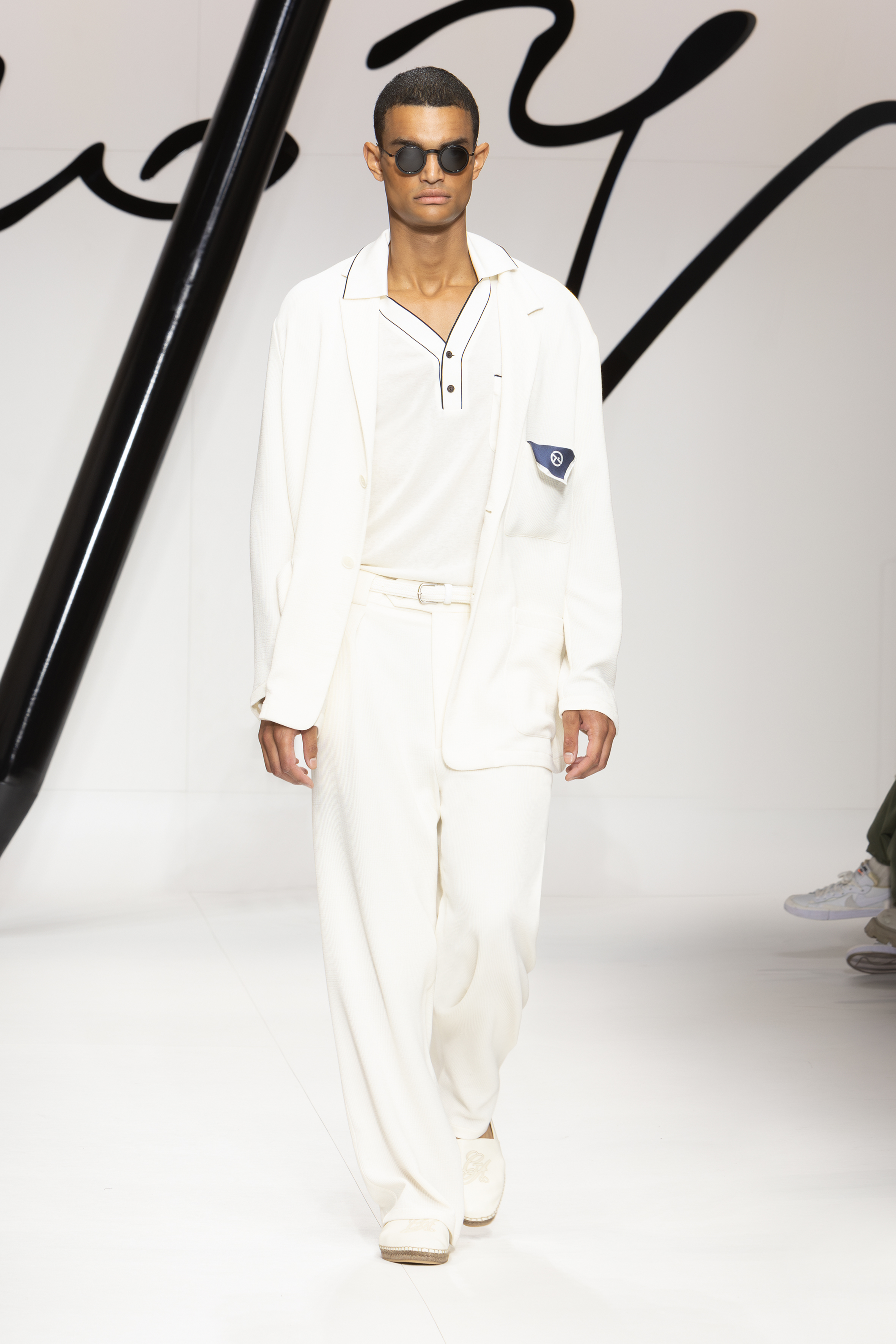
Giorgio Armani S/S 2024
A giant pencil stood at the end of the Giorgio Armani runway, held in the dedicated theatre in the basement of the house’s spiritual home on Milan’s Via Borgonuovo. Its purpose was metaphorical, the designer likening it to the way he has consistently written and rewritten the codes of Armani since its founding in 1975. ‘Narrating a certain style is a constant process… examining familiar elements from different angles to craft new plots and weave new stories,’ said the house. If not a greatest hits per se, the collection instead elegantly distilled Armani signatures: liquid tailoring was elongated in proportion, geometric patterns recalled memorable archival prints, while sportier references came in a series of looks which were reminiscent of traditional tennis whites. Flights of craft ran throughout: like delicate intertwining threads and knotted sandals and shoes, designed to evoke the fluidity of handwriting.
JW Anderson
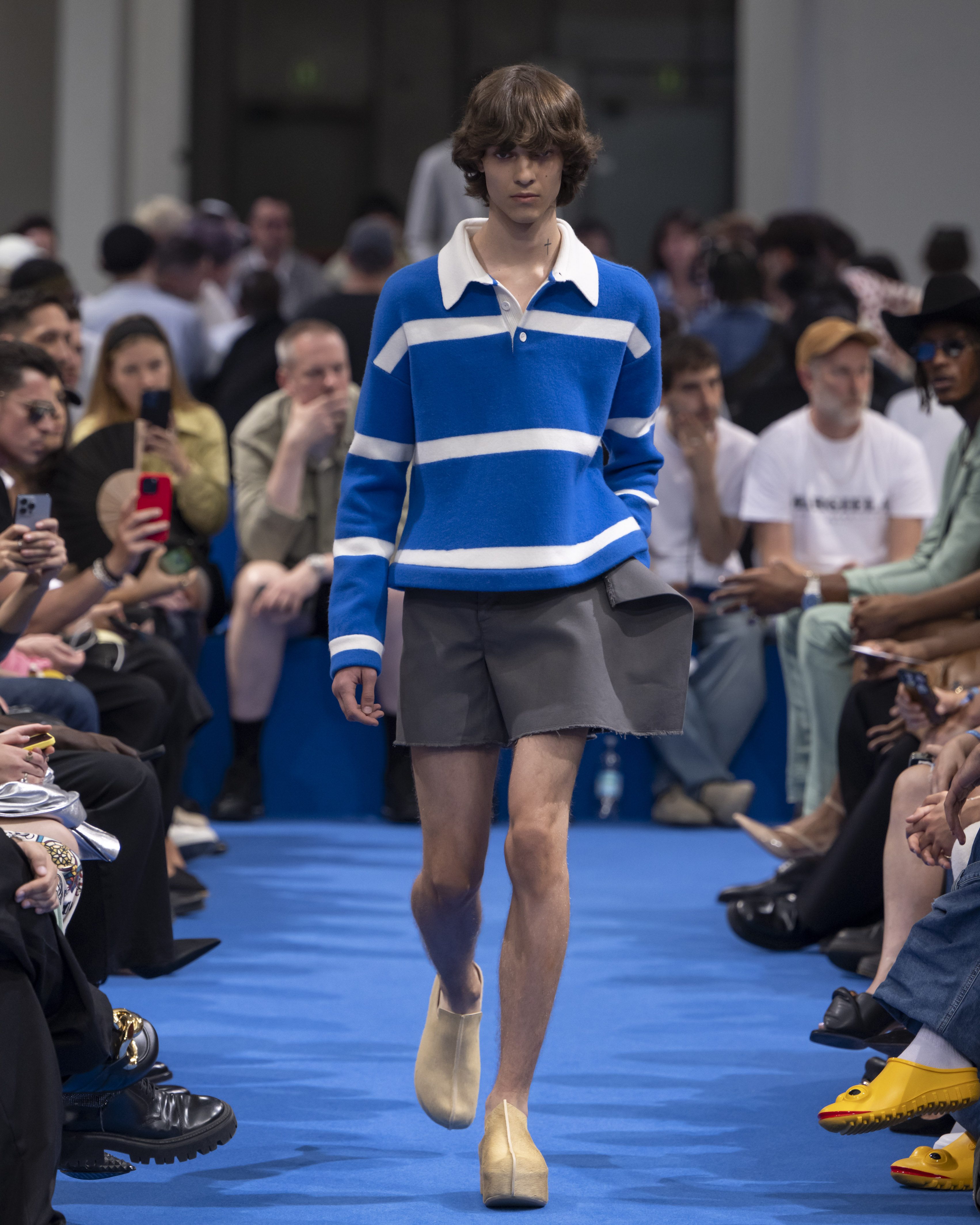
JW Anderson S/S 2024
Backstage after the show, a relaxed Jonathan Anderson said there had been ‘no angst’ in the creation of his latest menswear collection, presented in Milan for the third season running. ‘I love showing here, it’s so calm,’ he explained, noting that recent months have seen him feeling ‘more creative’ having been working alongside Italian filmmaker Luca Guadagnino on the costumes for his upcoming feature Queer. The latter experience, he said, had got him thinking about the idea of realism, a mood reflected in the collection itself – there was a real-world simplicity to the boxy striped rugby shirts, tie-waist sweatpants and hoodies. ‘Ease… the fluency of restarting after setting a blank slate,’ read the collection notes; ‘we’re still in this moment of reduction,’ he said after the show.
One reference, he said, was the everyday textures and patterns of the home: furniture upholstery, woven carpets and tableware, the last referenced in the collection’s invitation – a striped blue and white teapot made by Cornishware, which celebrates its 100th birthday this year. The stripes ran throughout the collection, continuing across the show’s sprawling runway and into the backstage area. Knitwear was abundant – over half the collection was constructed from knit fabrics – culminating in colourful woven knits reminiscent of shag-pile 1970s carpets or balls of yarn. ‘A sense of plainness, and calm, that is not so plain, not so calm,’ said the collection notes. Or, in Anderson’s words: ‘it is what it is.’
Wallpaper* Newsletter
Receive our daily digest of inspiration, escapism and design stories from around the world direct to your inbox.
Prada
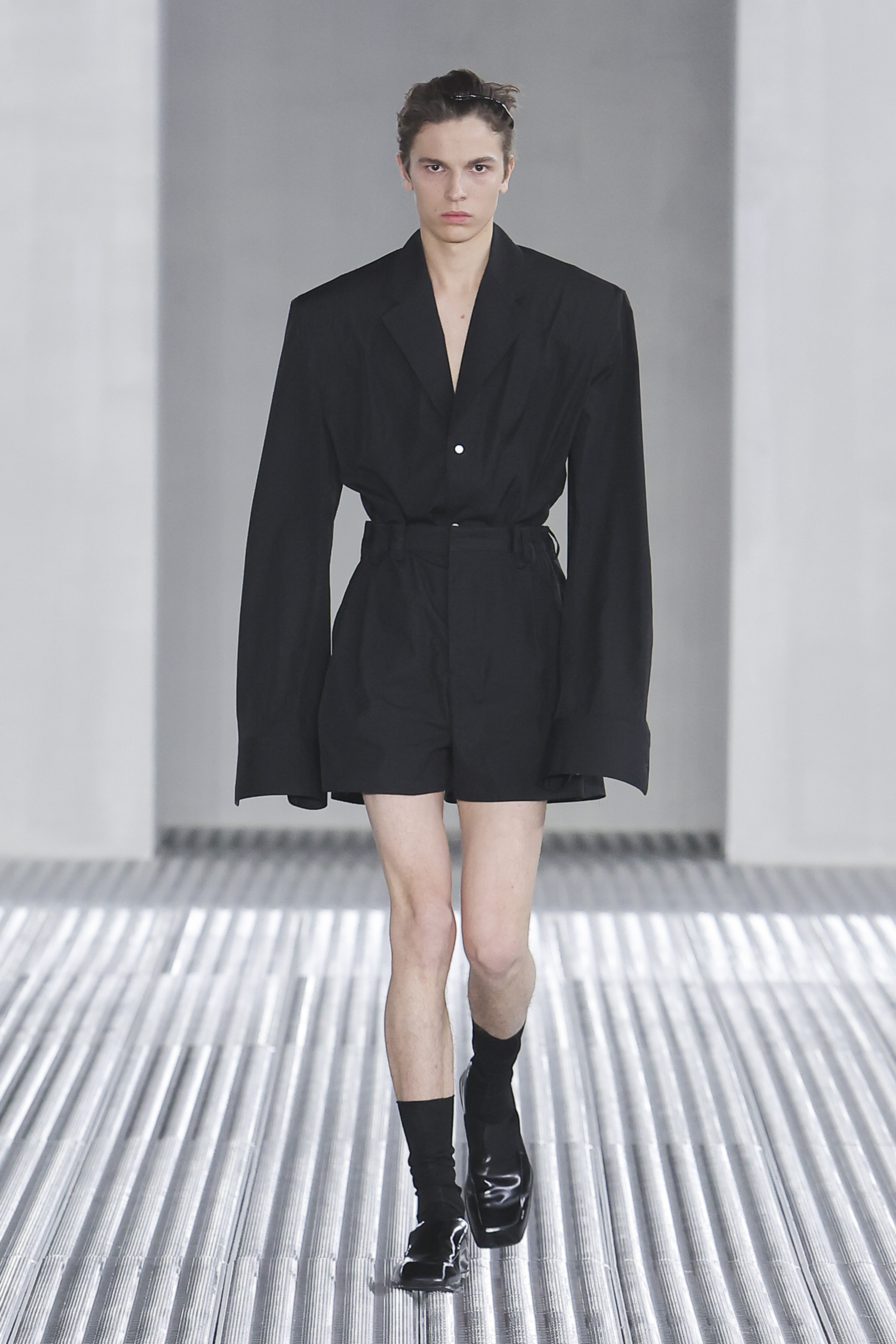
Prada Men’s S/S 2024
‘Fluid interruptions’ was how Prada described the sheets of slime which began to drip, Alien-like along the stainless steel runway as the house’s latest menswear show began. Such a juxtaposition – the stark, sci-fi-like perfection of the space interrupted by oozing goo that pooled into green mounds on the floor – spoke to the central idea of the collection, which was a musing on restriction and fluidity. Titled ‘Fluid Forms’, Prada called it ‘an examination of fluid architecture around the human body’.
The season began, said co-creative directors Miuccia Prada and Raf Simons, with the archetypal men’s white shirt. ‘We start with the white shirt – the most simple. And from that base, from a base of the most basic and normal, you can do whatever you like. It allows transformation, and individuality,’ said the former. It marked a shift, she noted, from recent seasons, where the pair have sought to reduce a garment to its essence. ‘Here, from something simple, we expand. Life and understanding of life is so complex – simplicity can be too simple. We were interested rather in this elaboration, in this expansion.’
So the pair sought to apply the white shirt’s feeling of ‘lightness, ease and comfort’ across the collection. It began with tailoring, which took the severe, masculine silhouette of the 1940s – narrow-waisted, wide across the shoulder – and reimagined it in ultra-fine fabrics as a riposte to restriction. ‘If you look at the tailoring in the show, it is a classicist man’s suit, but when you actually see it, it feels completely different. It allows the body, which is always in movement and always in transformation, to feel free,’ said Simons. ‘We were thinking a lot about the body – to give freedom to the body, even if our interest is to show references to archetypes and architecture in fashion, which is usually restrictive.’
It led to what Mrs Prada called a musing on ‘the individuality of people, and therefore about an individuality of thinking’, expanding outwards from the simplicity of the inspiration towards vivid expressions of colour and print – shirts bloomed with appliqué flowers, others were decorated by fringing, while classic polo knits sprouted faux fur along the seams and lightweight anoraks arrived in an array of Prada-esque hues. As the designer noted after the show, despite its influence, the white shirt itself ‘disappeared’ entirely from the collection. ‘Sophistication of thoughts, allow a reconsideration of simple things,’ she said.
Tod’s
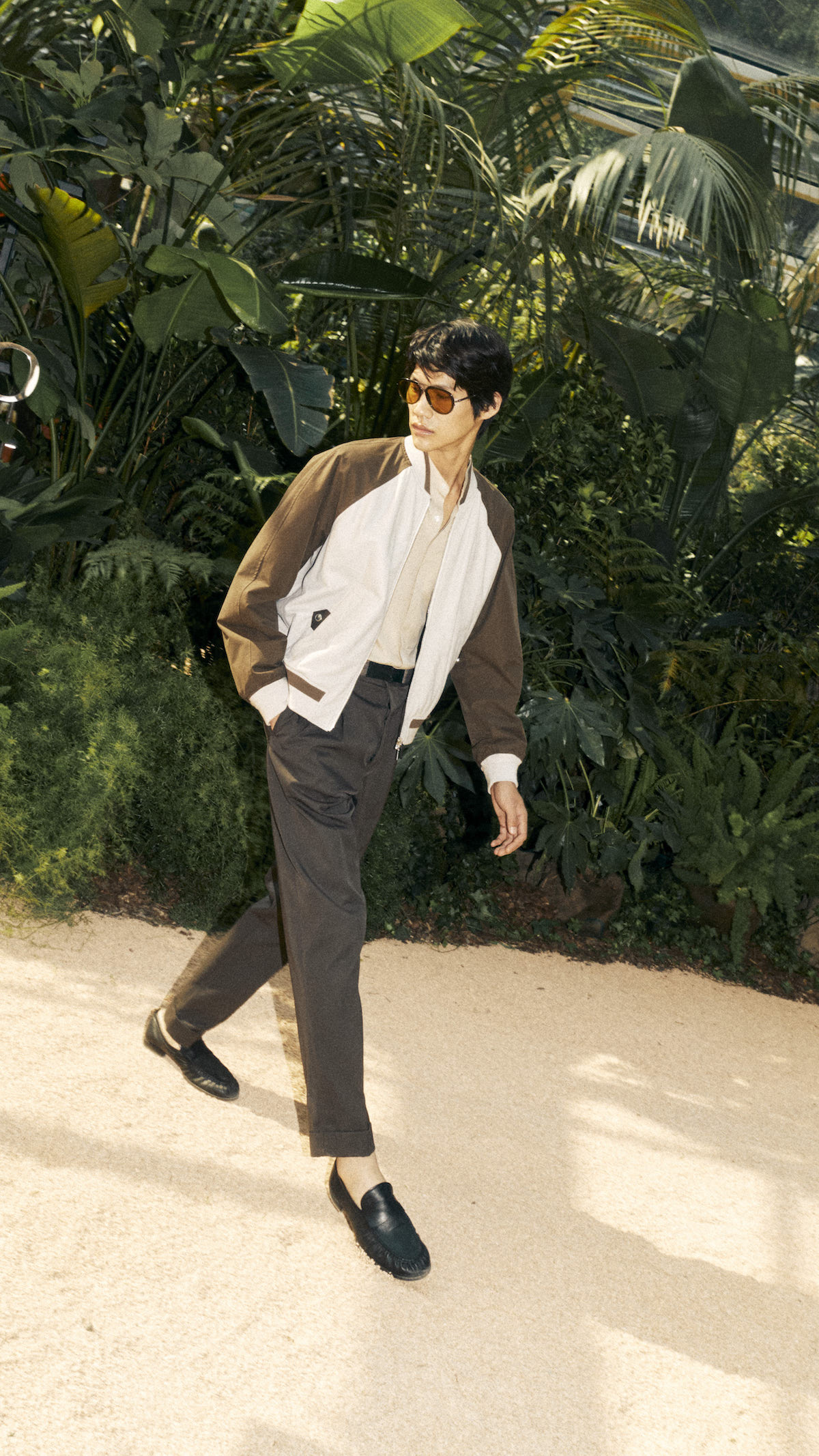
Tod’s S/S 2024
Presented in the lush gardens of Villa Necchi Campiglio, the Piero Portaluppi-designed home perhaps best known for its starring role in Luca Guadagnino’s I Am Love, Tod’s latest collection reflected the sun-soaked ease of its surroundings. Rooted in Tod’s history of craftsmanship – ‘Italian craftsmanship and the excellent quality are the protagonists of the collection,’ said the notes – pieces spanned easy, casual tailoring in tones of tan and ecru, buttery leather shirts, and relaxed riffs on the varsity jacket. The classic Tod’s ‘Gommino’, the brand’s signature slip-on driving shoe, appeared throughout the presentation, while moccasins, tasseled slip-ons, and new versions of the ‘Tab’ sneaker completed the footwear offering for the season.
Etro
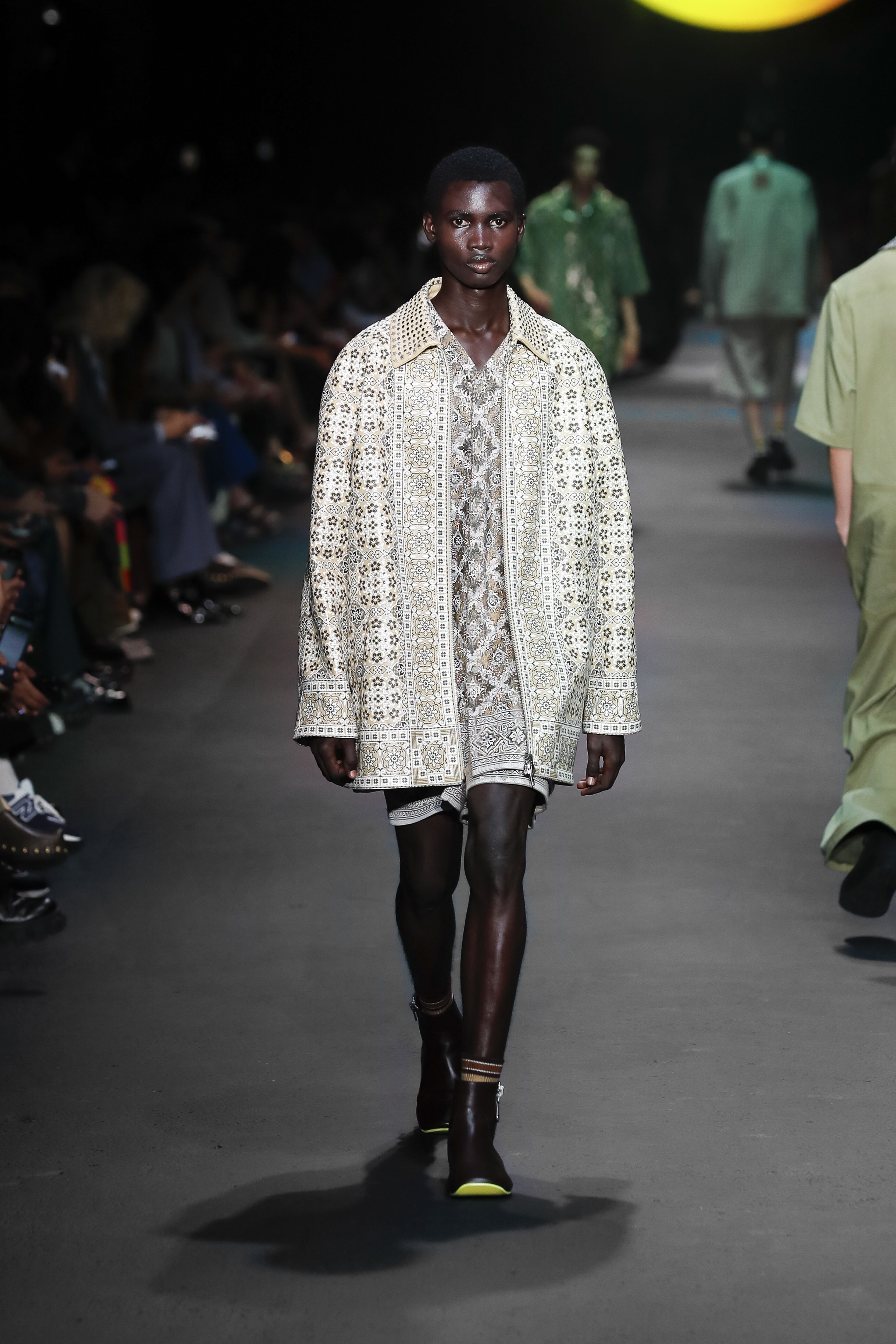
Etro S/S 2024
‘How does a book collecting anonymous depictions of allegories, found by pure chance in an old bookstore in the city of Messina, relate to the present moment, and to fashion making in particular?’ began the collection notes for Marco de Vincenzo’s latest menswear outing at Etro. The discovery of a 17th-century tome by Cesar Ripa – filled with allegorical images ‘depicting virtues, qualities and vices’ – provided the inspiration for a richly crafted collection. The link to the present day? The way that such allegorical images were the Renaissance-era equivalent of modern-day Gifs and TikToks. Getting dressed, said De Vincenzo, is a similarly symbolic gesture – the subtle meanings behind our choices of clothing, how fashion itself is an act of ‘make believe’. Esoteric explanations beside, the collection was an expansive demonstration of De Vincenzo’s intuitive and eclectic vision for the house, shifting between fluid, bohemian elements – blanket-like coats, elongated cardigans, shimmering printed shirts – and Renaissance-inflected motifs, courtesy of Ripa, which decorated playful football-style jerseys.
Magliano
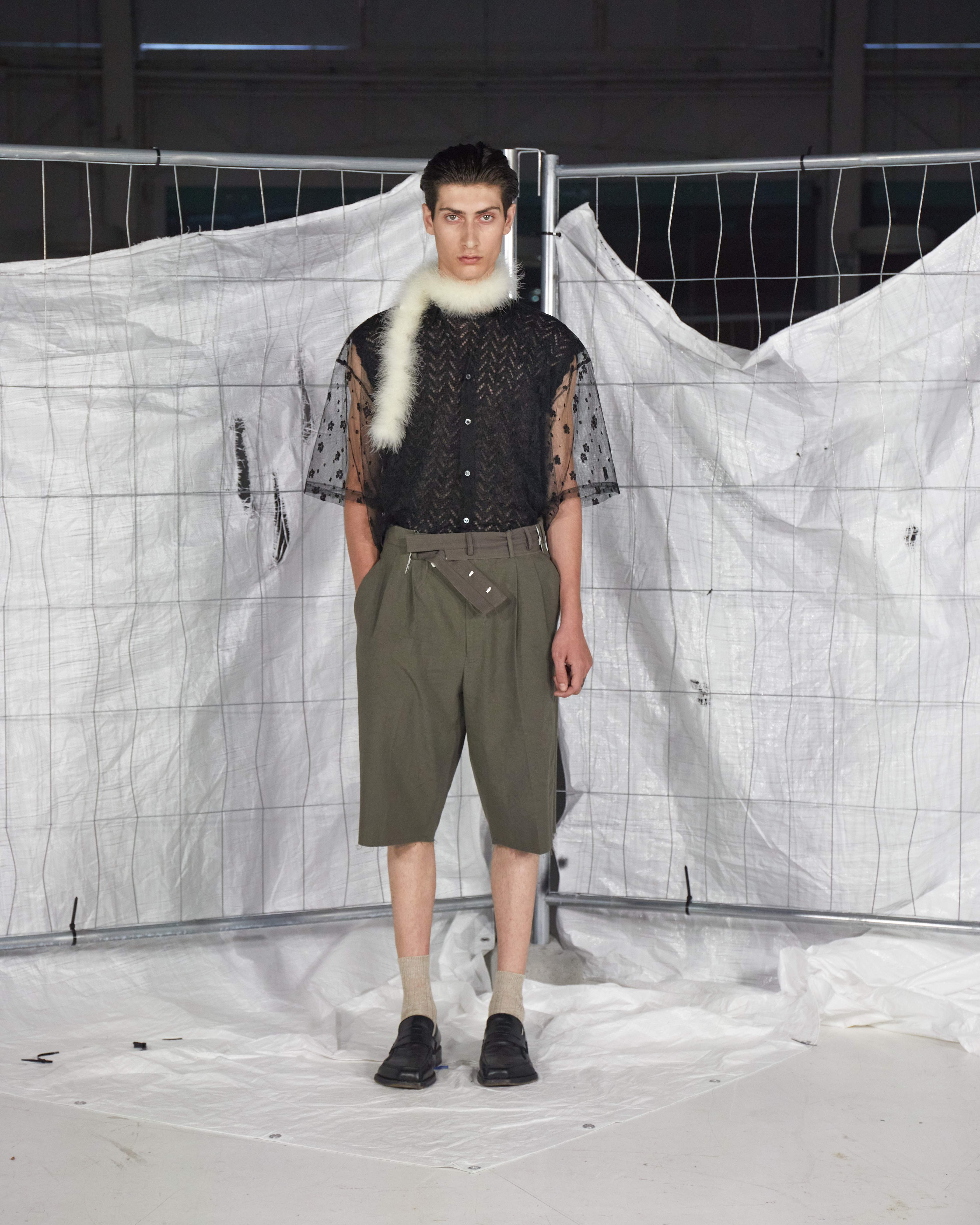
Magliano S/S 2024
Luca Magliano was the recipient of the Karl Lagerfeld Award at this year’s LVMH Prize, a nod of recognition that speaks to the growing buzz – and intrigue – surrounding the Bologna-based designer at Milan Fashion Week. On Sunday morning, he staged his first-ever runway show; building site-style metal fences and white tarpaulins surrounded the elevated catwalk, a suggestion that Magliano is still a work in progress. ‘For the first time, a proper runway works as a sincere invitation: “come see us”,’ read the accompanying notes, with various garments in the collection offering slogans of ‘prayers, epigraphs and thanksgivings’ (16th-century nun Teresa of Ávila was quoted on the press release).
The collection itself continued Magliano’s deft plays on everyday garments – warped in proportion, dishevelled and undone, but nonetheless imbued with a feeling of elegance. Deconstructed overalls, bombers and windbreakers were reshaped into what Magliano called ‘a wretched couture’, while glimmers of crystal and delicate marabou-style boas spoke of lost glamour. The deep-thinking designer said that Italian writer Alda Merini was this season’s patron saint; in her intense, passionate writings she made sacred moments of the everyday, a reflection of Magliano’s own desire to transform the quotidian.
Emporio Armani
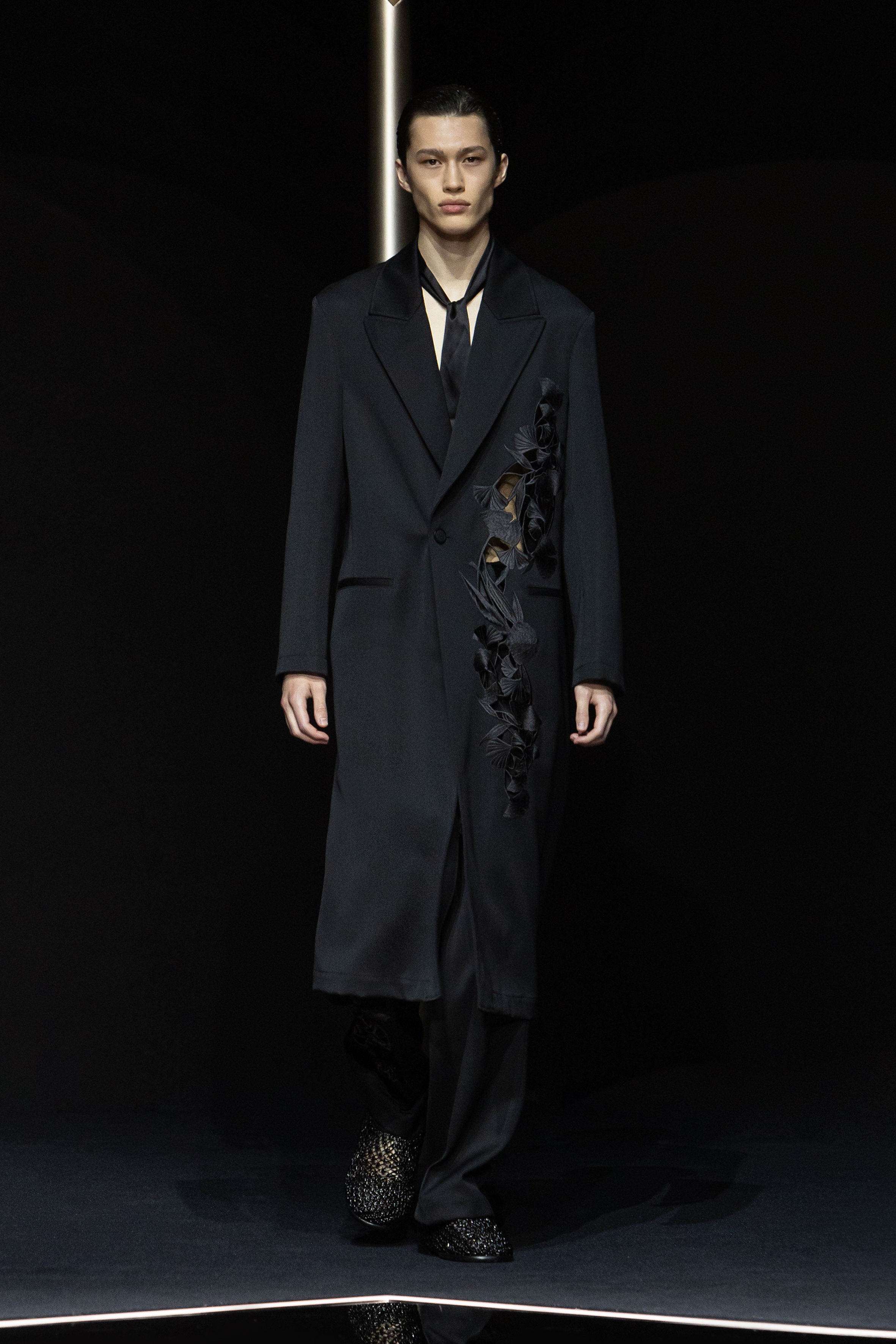
Emporio Armani S/S 2024
A vast recreation of the Chinese ginkgo tree provided the backdrop to Giorgio Armani’s latest Emporio collection, chosen for its ‘elegance and endurance’ – an apt metaphor for the collection itself, which the house said was ‘a return to the essence of Emporio Armani, purified to the core and seen through the filter of moonlight’. Drawing inspiration from world travel – silhouettes referenced at once Italian sartorialism and the ease and construction of traditional Chinese dress – the comprehensive collection spanned louche tailoring and diaphanous sheer and silk shirts (notes described ‘liquid lines that barely touch the muscles’), an array of tunic-style silhouettes, and sportier cuts, like a voluminous wide-legged trouser with sweatband-style waistband. The show ended with the news that Mr Armani has created team Italy’s kit for the Paris 2024 Olympics and Paralympics, the designer joined on the runway by a series of athletes in the kit, each one wielding the Italian flag.
Dolce & Gabbana
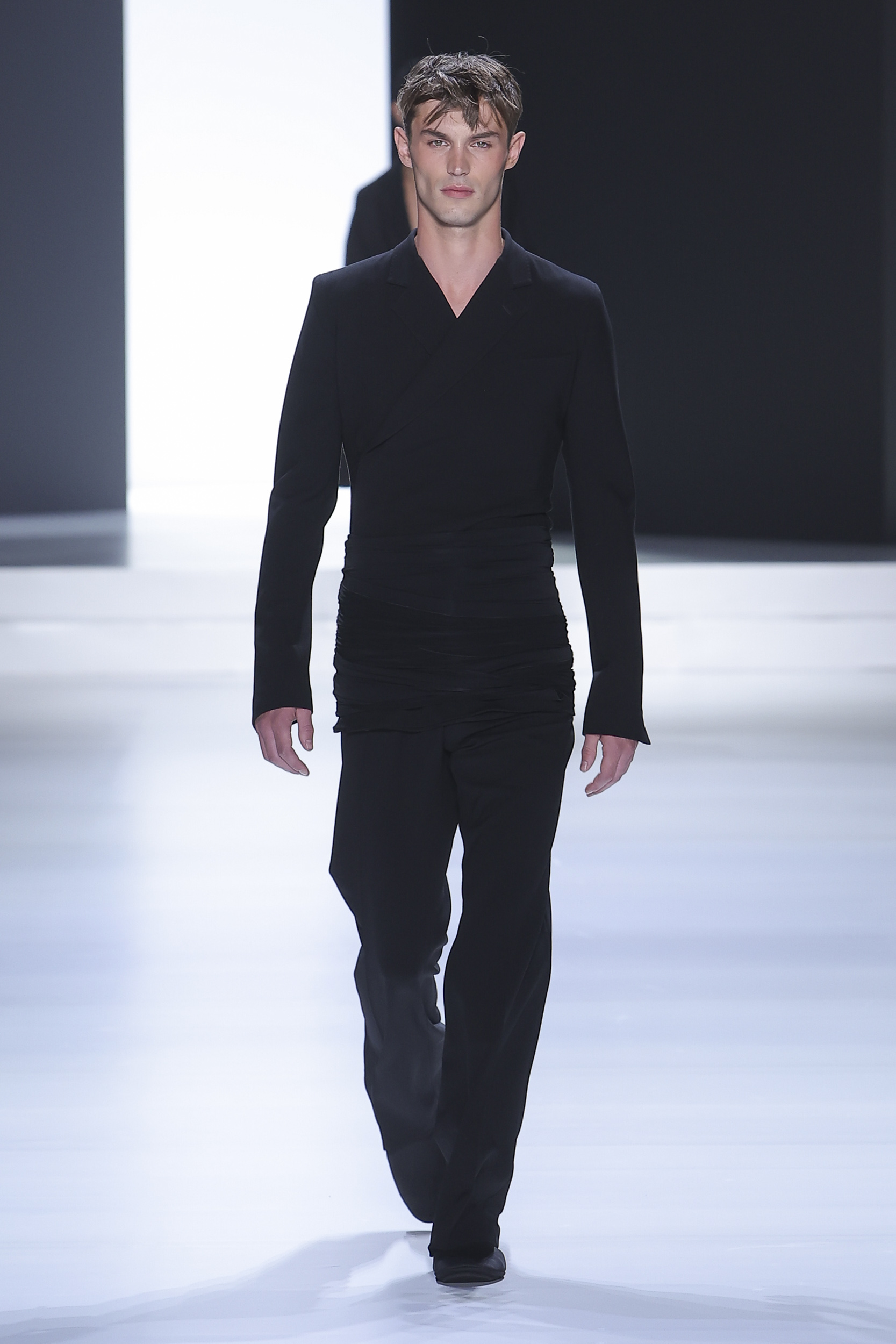
Dolce & Gabbana S/S 2024
‘Respect for identity, for an imagery that has been created over time,’ described the collection notes for Domenico Dolce and Stefano Gabbana’s latest collection, which was part of a continuing attempt – at both the house’s menswear and womenswear collections – to return to the distinct essence of Dolce & Gabbana and the pieces with which it is most synonymous (‘the tank-top, the coppola, the rosary, the black, the jacket, Sicily’, said the house). As such, the collection was titled ‘Style’ – a reference to the rejection of ephemeral trends towards something more timeless – comprising elegant black tailoring (with occasional moments of brown, camel and white), narrow at the waist and flaring towards a wider, voluminous trouser. Other continuing motifs were a series of wrapped silhouettes, fabric looping sensually around the body, or continuing plays on exposure and transparency (from diaphanous sheer organza to lace pyjama-style tailoring). Moments of embellishment showed off the savoir-faire of the Dolce & Gabbana atelier; notably, a series of delicate flowers which hovered over jackets and shirts.
MSGM
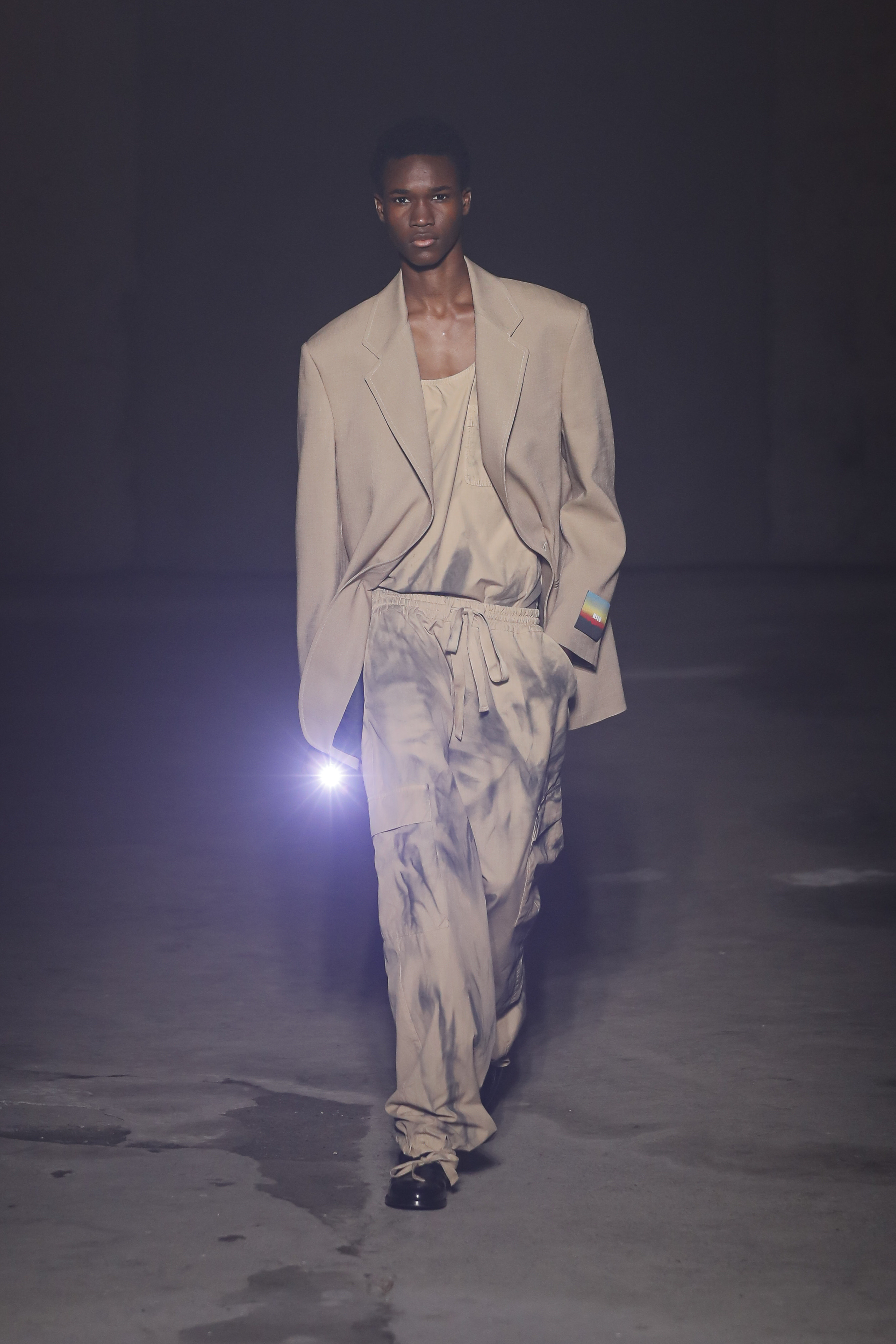
MSGM S/S 2024
Titled ‘Sogno Off Road’, Massimo Giorgetti’s latest collection was inspired by a recent trip to Tanzania. Memories of the country infused the collection with a feeling of wanderlust – vests were decorated with images of sunrises and sunsets (the photographs had been taken by Giorgetti using his iPhone on his travels), oversized utility jackets and cargo pants riffed on safari wear, while textures and colours were drawn from the distinct landscapes of the east African country (from earthy hues of sand, brown and green to vivid blues and oranges inspired by sky and sun). Giorgetti said that he wanted the collection – perhaps his tightest menswear outing in recent seasons – to feel like the moment of promise when the sun rises, ‘illuminating uncharted lands [and] heralding the dawn of a new day’.
Gucci
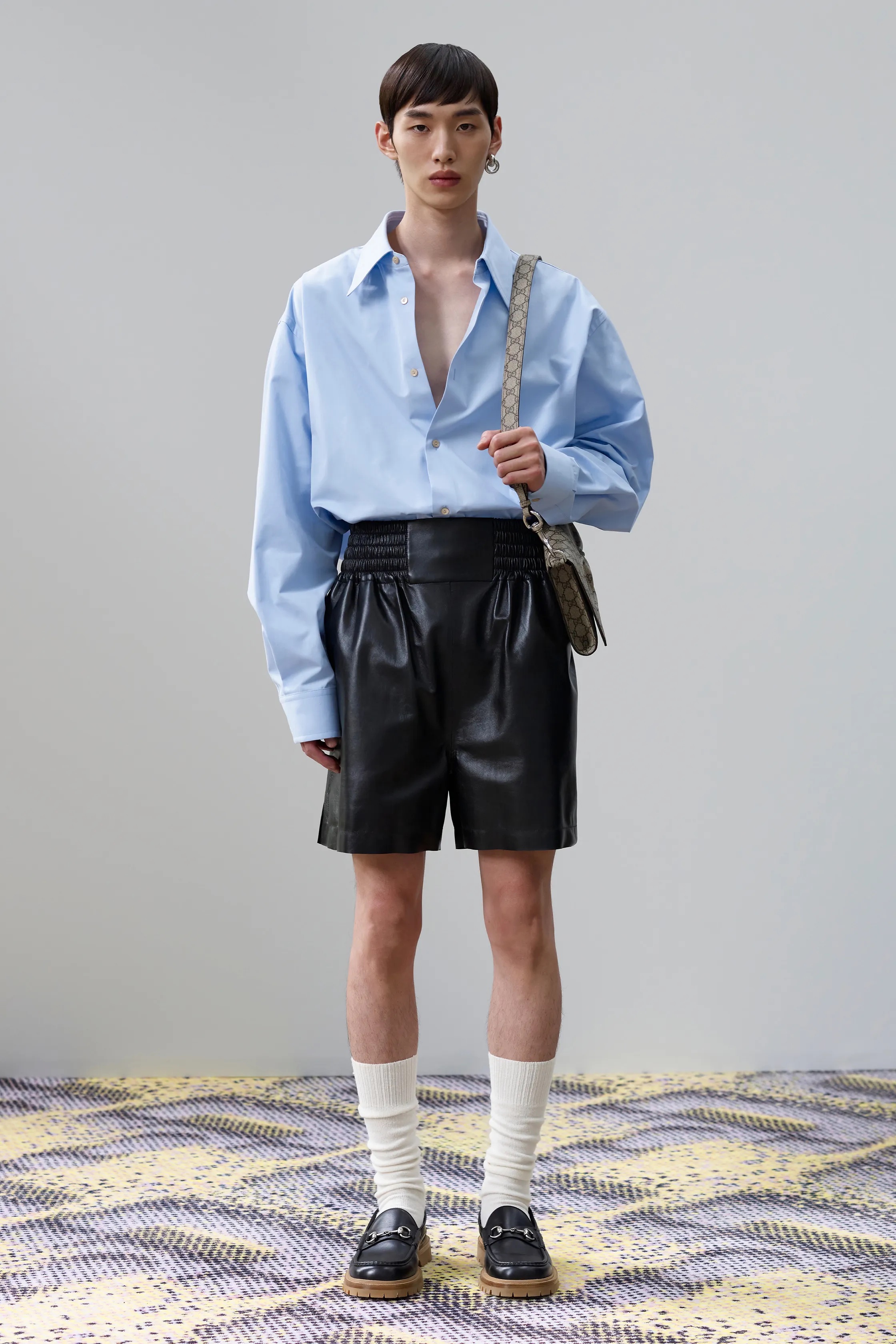
Gucci S/S 2024
Gucci’s latest menswear collection – which will mark the last created by the in-house design team before the debut of new creative director Sabato De Sarno – looked towards the ‘iconography’ of the house for an exercise in ‘adaption, deconstruction and reconstruction’. Namely, the house’s signature ’Horsebit’ loafer, introduced by Aldo Gucci in 1953 and featuring a miniature metal clamp like those found on a horse’s bridle. Since, it has become one of the house’s most recognisable emblems appearing across clothing, handbags, and shoes; as such, a special event to coincide with the menswear collection saw Milan-based curator and creative director Alessio Ascari gather several artists at the Spazio Maiocchi to reinterpret the style. These included photographer Charlie Engman, multi-media artist Harry Nuriev and designer Gyuhan Lee, each creating vivid ’rooms’ in a surreal country club playfully titled the ‘Gucci Horsebeat Society‘ (the exhibition will be open to the public from 17-18 June 2023). The collection itself flickered across screens in the space, comprising what the house called its take on a ’classic men’s wardrobe’ spanning louche wide-leg tailoring, oversized embroidered denim and sportier short sets featuring Gucci emblems – from the horsebit (here as a digital print on an oversized shirt) to the house’s signature GG boucle.
Valentino
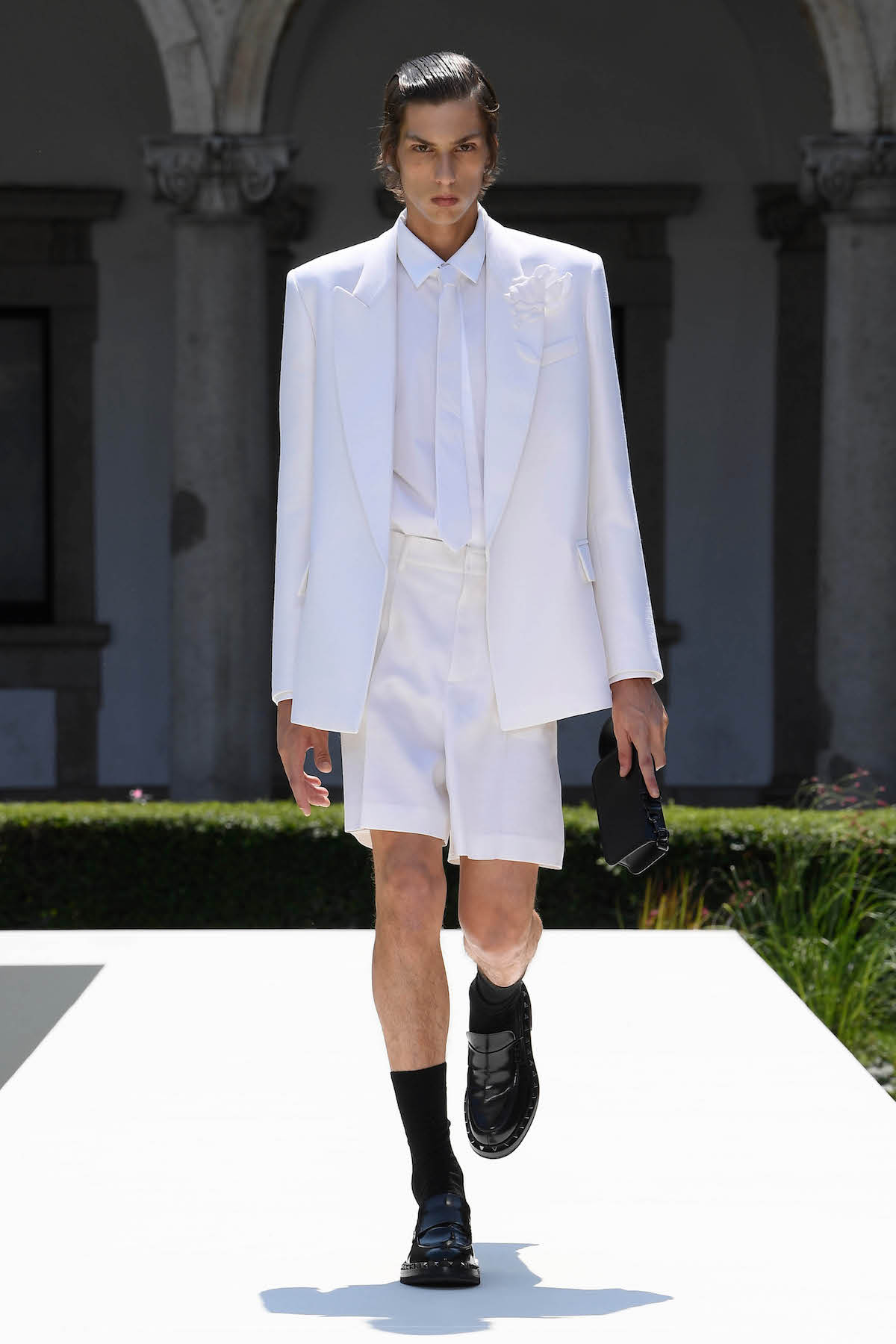
Valentino S/S 2024
The invitation for the Valentino show was a special copy of Hanya Yanagihara’s 2015 novel A Little Life, a sprawling exploration of male friendship in New York City. Marking the Roman house’s return to the menswear schedule – recent seasons have seen the house present co-ed offerings – and also to Milan, where Valentino Garavani staged the first Valentino menswear show in 1985, the novel proved an apt counterpoint to a collection that creative director Pierpaolo Piccioli said was an attempt to ‘redefine an identity of men, to re-examine a meaning of masculinity’. Held in the courtyard of Milan’s Università Statale di Milano against a live soundtrack from New York musician D4vd, the poetic offering combined sartorial elegance – much of the collection focused on tailoring, gently oversized or elongated – with romantic flourishes, from blooming floral prints to quotes from Yanagihara’s novel printed on bags and shirts (’we are so old, we have become young again’, was one such slogan). Piccioli also noted a feeling of fragility in the collection, referencing the Japanese concept of ‘kintsugi’ (’golden seams’), which denotes the power of imperfection and repair. ‘A strength can be found in fragility, a power in gentleness, a perfection in imperfection,’ he said via the collection notes, likening it to his desire to reconsider ‘the life of men, the life of their clothes, the reality of masculinity now’.
Jack Moss is the Fashion Features Editor at Wallpaper*, joining the team in 2022. Having previously been the digital features editor at AnOther and digital editor at 10 and 10 Men magazines, he has also contributed to titles including i-D, Dazed, 10 Magazine, Mr Porter’s The Journal and more, while also featuring in Dazed: 32 Years Confused: The Covers, published by Rizzoli. He is particularly interested in the moments when fashion intersects with other creative disciplines – notably art and design – as well as championing a new generation of international talent and reporting from international fashion weeks. Across his career, he has interviewed the fashion industry’s leading figures, including Rick Owens, Pieter Mulier, Jonathan Anderson, Grace Wales Bonner, Christian Lacroix, Kate Moss and Manolo Blahnik.
-
 Japan in Milan! See the highlights of Japanese design at Milan Design Week 2025
Japan in Milan! See the highlights of Japanese design at Milan Design Week 2025At Milan Design Week 2025 Japanese craftsmanship was a front runner with an array of projects in the spotlight. Here are some of our highlights
By Danielle Demetriou
-
 Tour the best contemporary tea houses around the world
Tour the best contemporary tea houses around the worldCelebrate the world’s most unique tea houses, from Melbourne to Stockholm, with a new book by Wallpaper’s Léa Teuscher
By Léa Teuscher
-
 ‘Humour is foundational’: artist Ella Kruglyanskaya on painting as a ‘highly questionable’ pursuit
‘Humour is foundational’: artist Ella Kruglyanskaya on painting as a ‘highly questionable’ pursuitElla Kruglyanskaya’s exhibition, ‘Shadows’ at Thomas Dane Gallery, is the first in a series of three this year, with openings in Basel and New York to follow
By Hannah Silver
-
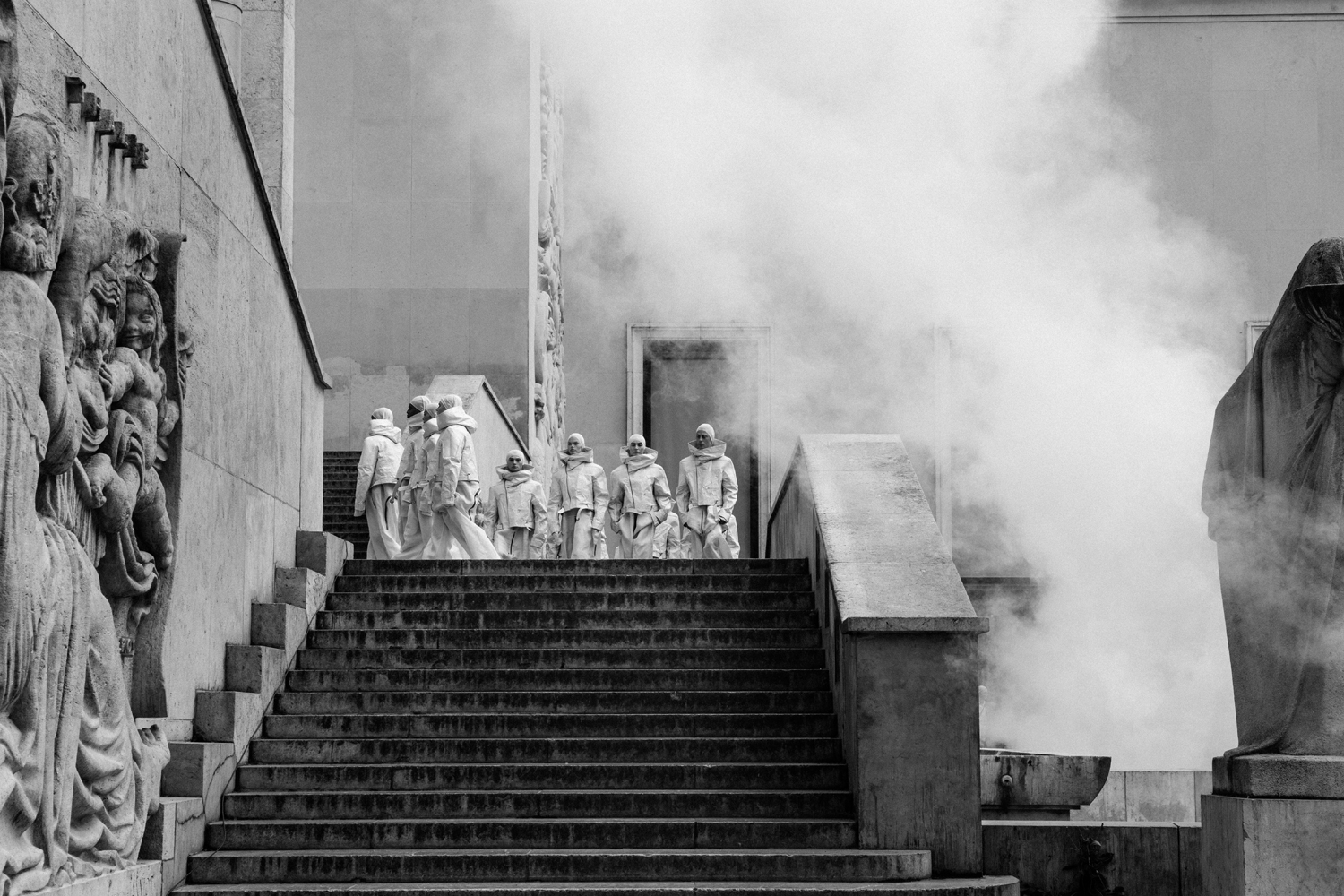 The Wallpaper* style team pick their fashion moments of 2024
The Wallpaper* style team pick their fashion moments of 2024The Wallpaper* style editors reflect on their best fashion moments of 2024, from Rick Owens’ 200-strong Hollywood epic to an Eyes Wide Shut-inspired JW Anderson show, and a slicked-back beauty look at Saint Laurent
By Jack Moss
-
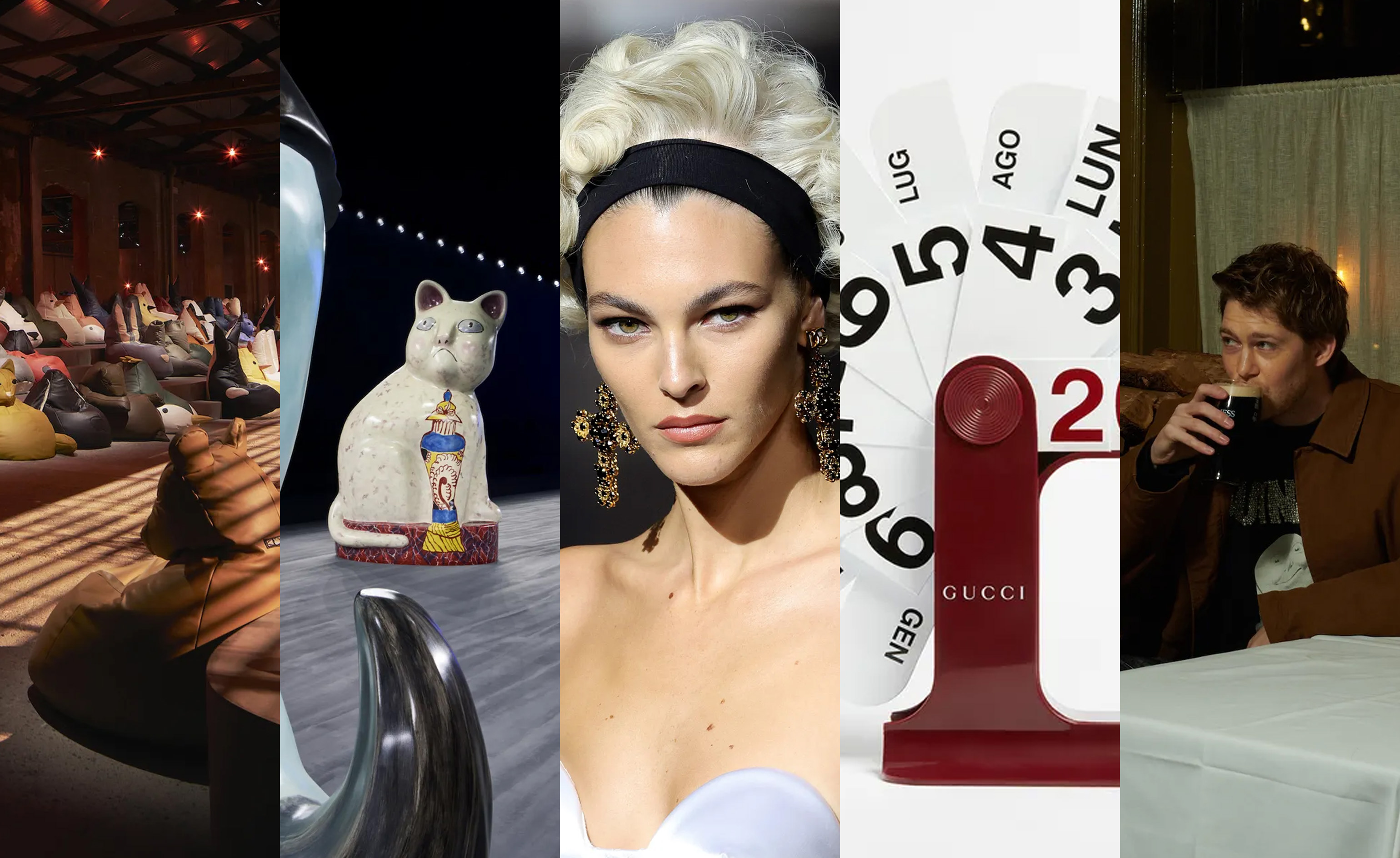 Giant cats, Madonna wigs, pints of Guinness: seven objects that tell the story of fashion in 2024
Giant cats, Madonna wigs, pints of Guinness: seven objects that tell the story of fashion in 2024These objects tell an unconventional story of style in 2024, a year when the ephemera that populated designers’ universes was as intriguing as the collections themselves
By Jack Moss
-
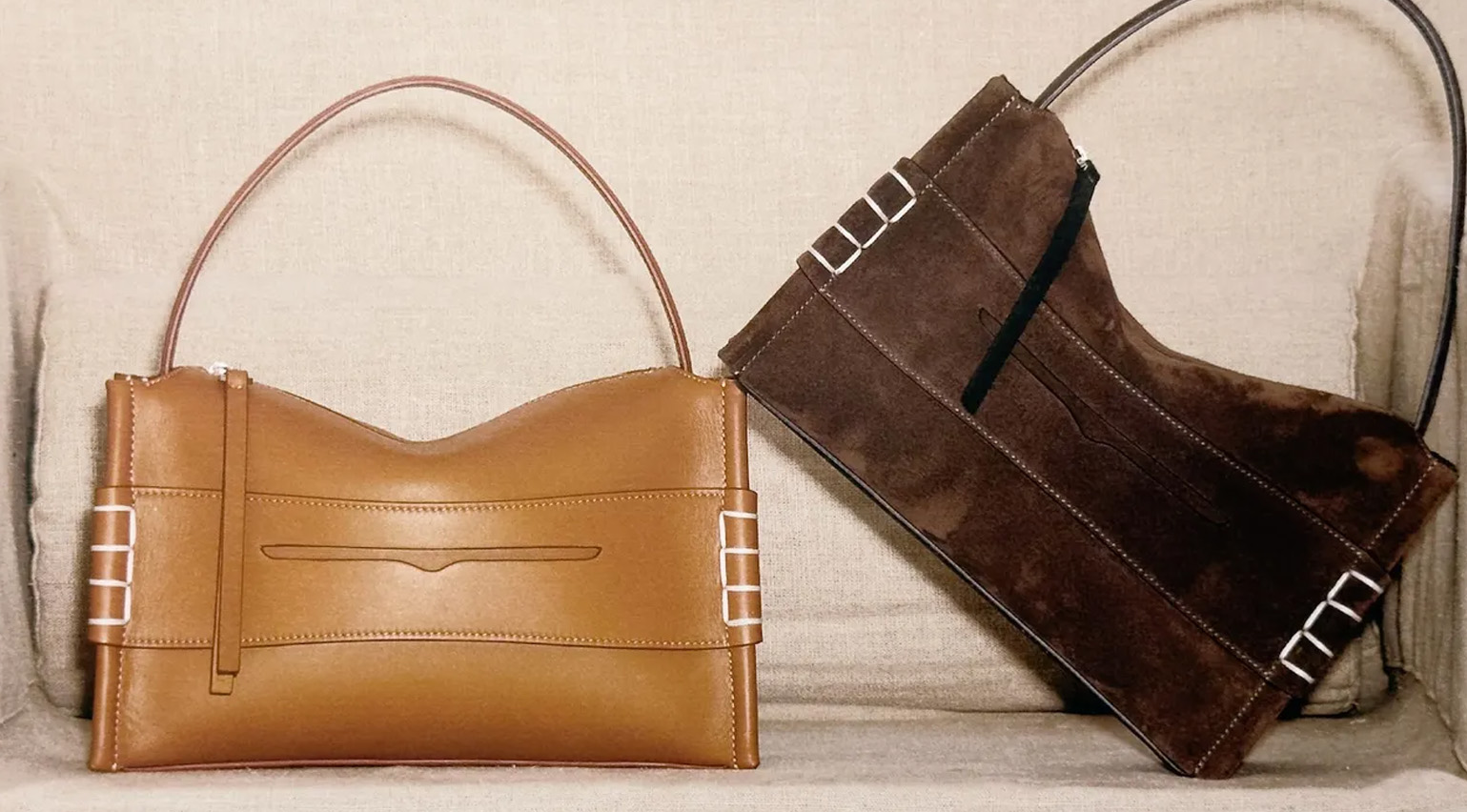 Loafer bags to sock shoes, 2024 was all about the mashed-up accessory
Loafer bags to sock shoes, 2024 was all about the mashed-up accessoryWallpaper* fashion features editor Jack Moss reflects on the rise of the surreal hybrid accessory in 2024, a trend which reflects the disorientating nature of contemporary living – where nothing is quite what it seems
By Jack Moss
-
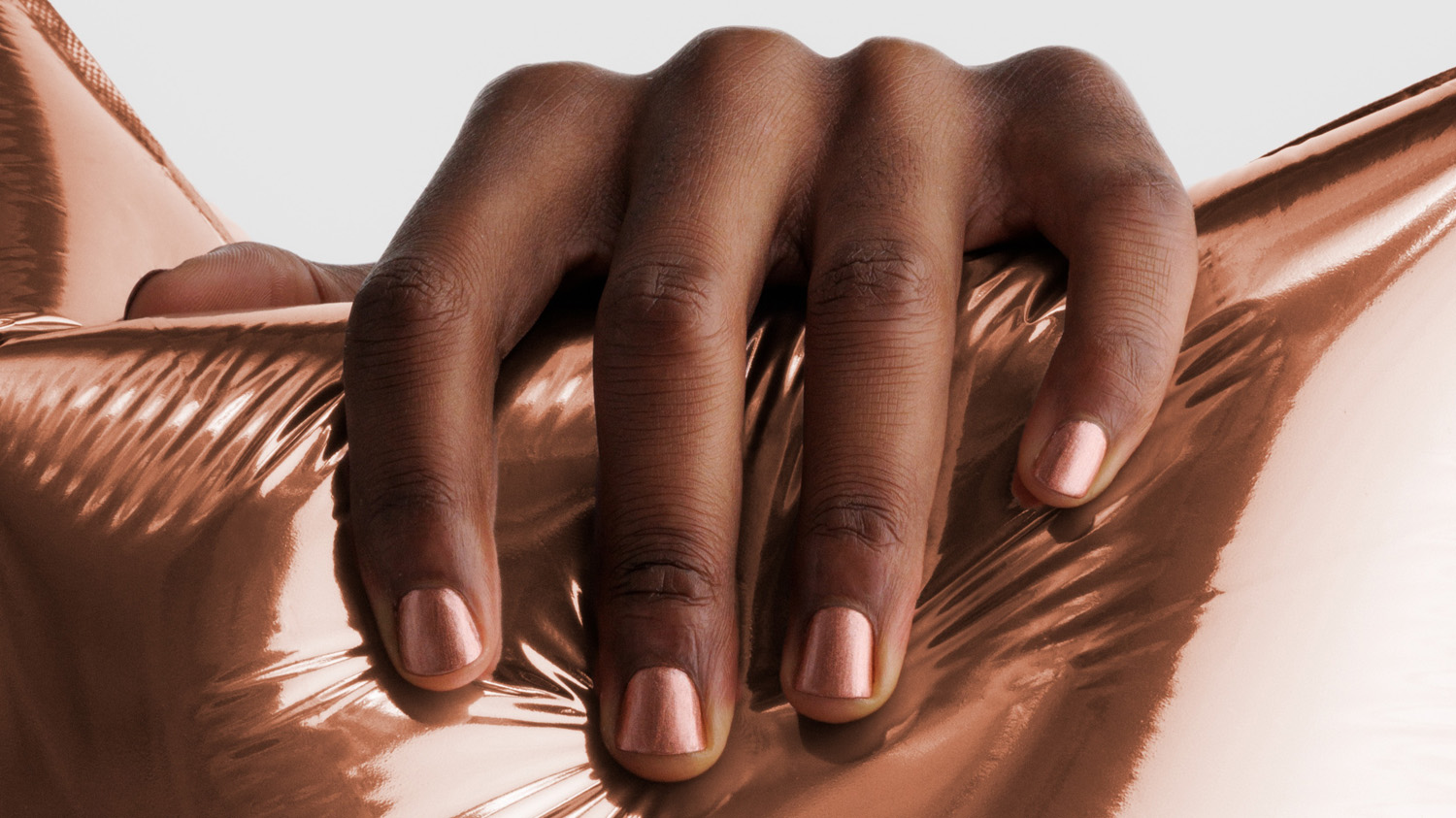 JW Anderson and Pleasing design a balloon-inspired collection of nail polishes and more
JW Anderson and Pleasing design a balloon-inspired collection of nail polishes and moreJW Anderson and Pleasing launch an uplifting new capsule collection featuring balloon-inspired metallic nail polishes and a take on the viral rainbow cardigan
By Hannah Tindle
-
 ‘He made something not merely popular, but the rage’: unpacking Elio Fiorucci’s fabulous fashion legacy
‘He made something not merely popular, but the rage’: unpacking Elio Fiorucci’s fabulous fashion legacyAn expansive new retrospective at Triennale Milano explores the colourful life and work of Elio Fiorucci, who is synonymous with 1970s hedonism and glamour
By Zoe Whitfield
-
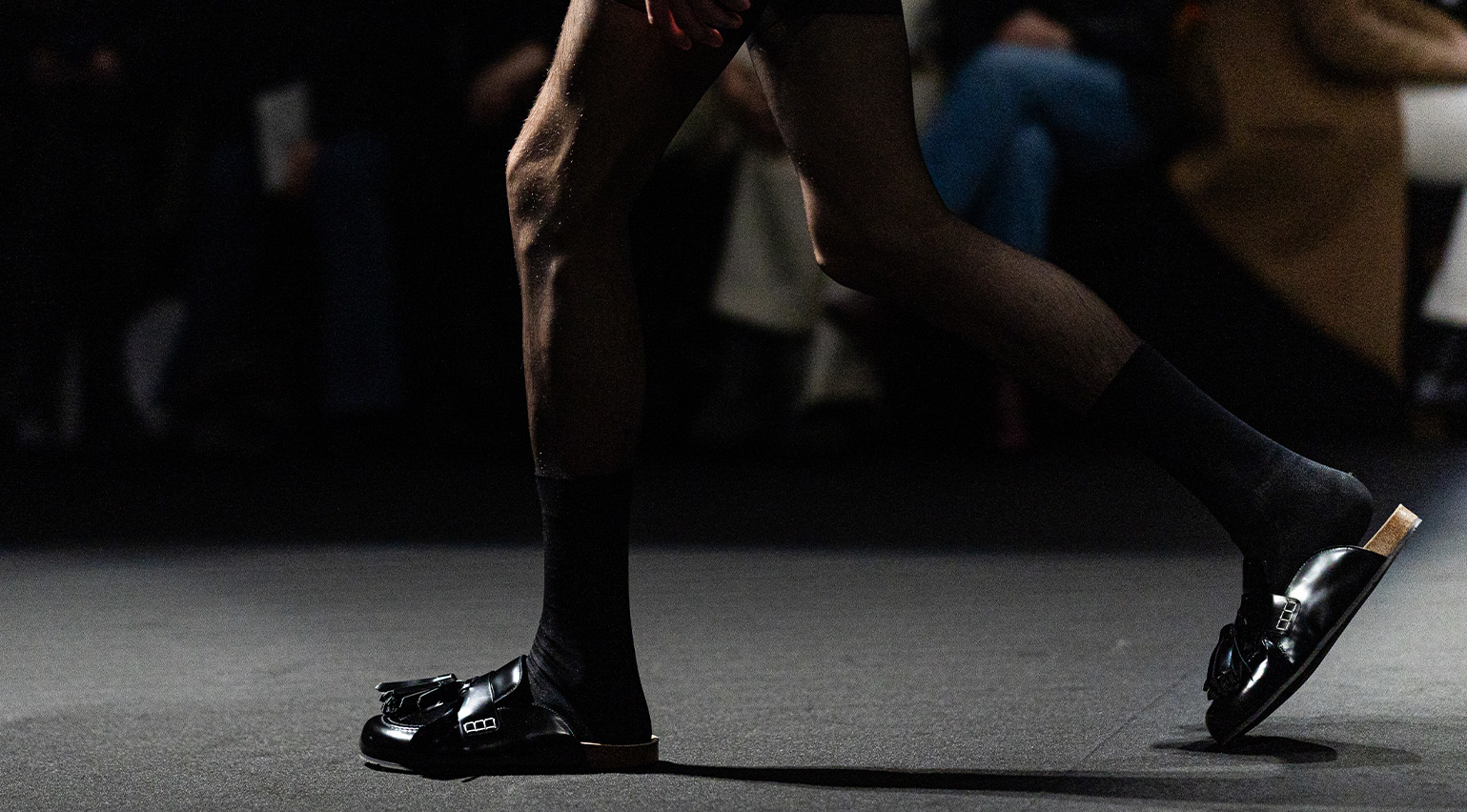 Why the slipper is set to be this season’s definitive men’s shoe
Why the slipper is set to be this season’s definitive men’s shoeWallpaper* fashion features editor Jack Moss unpacks the rise of the men’s slipper, which looks set to become this season’s most ubiquitous shoe. Plus, five styles to channel the slipper’s louche elegance in your own wardrobe
By Jack Moss
-
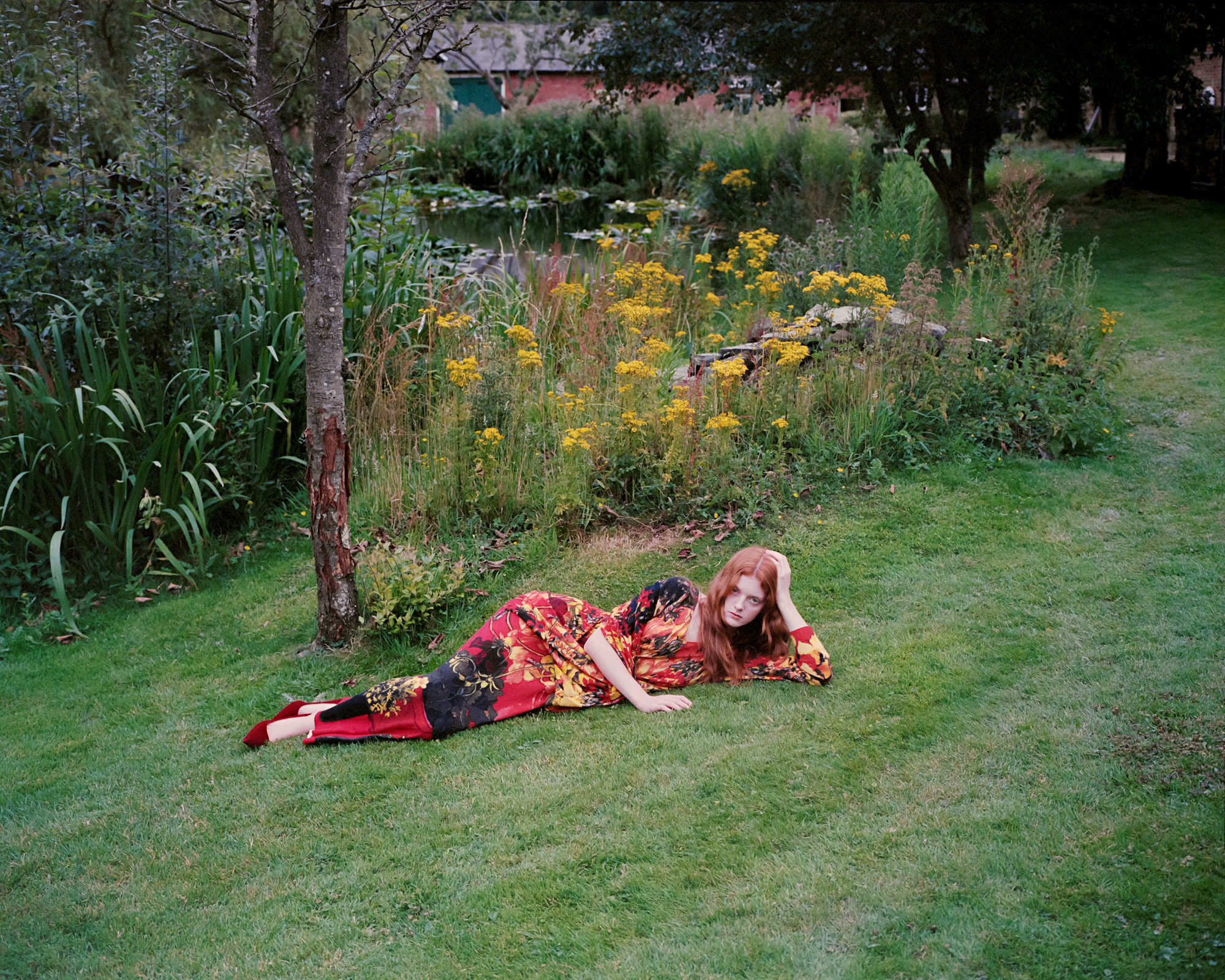 ‘Her work is a compulsion’: Jonathan Anderson on uniting with artist Christiane Kubrick on a collection inspired by Eyes Wide Shut
‘Her work is a compulsion’: Jonathan Anderson on uniting with artist Christiane Kubrick on a collection inspired by Eyes Wide ShutA rewatching of Stanley Kubrick’s final movie laid the foundation for JW Anderson’s latest collection, which featured a fantastical collaboration with artist Christiane Kubrick, the director’s wife. Here, Wallpaper* travels to the Kubrick manor in Hertfordshire to capture the collection
By Jack Moss
-
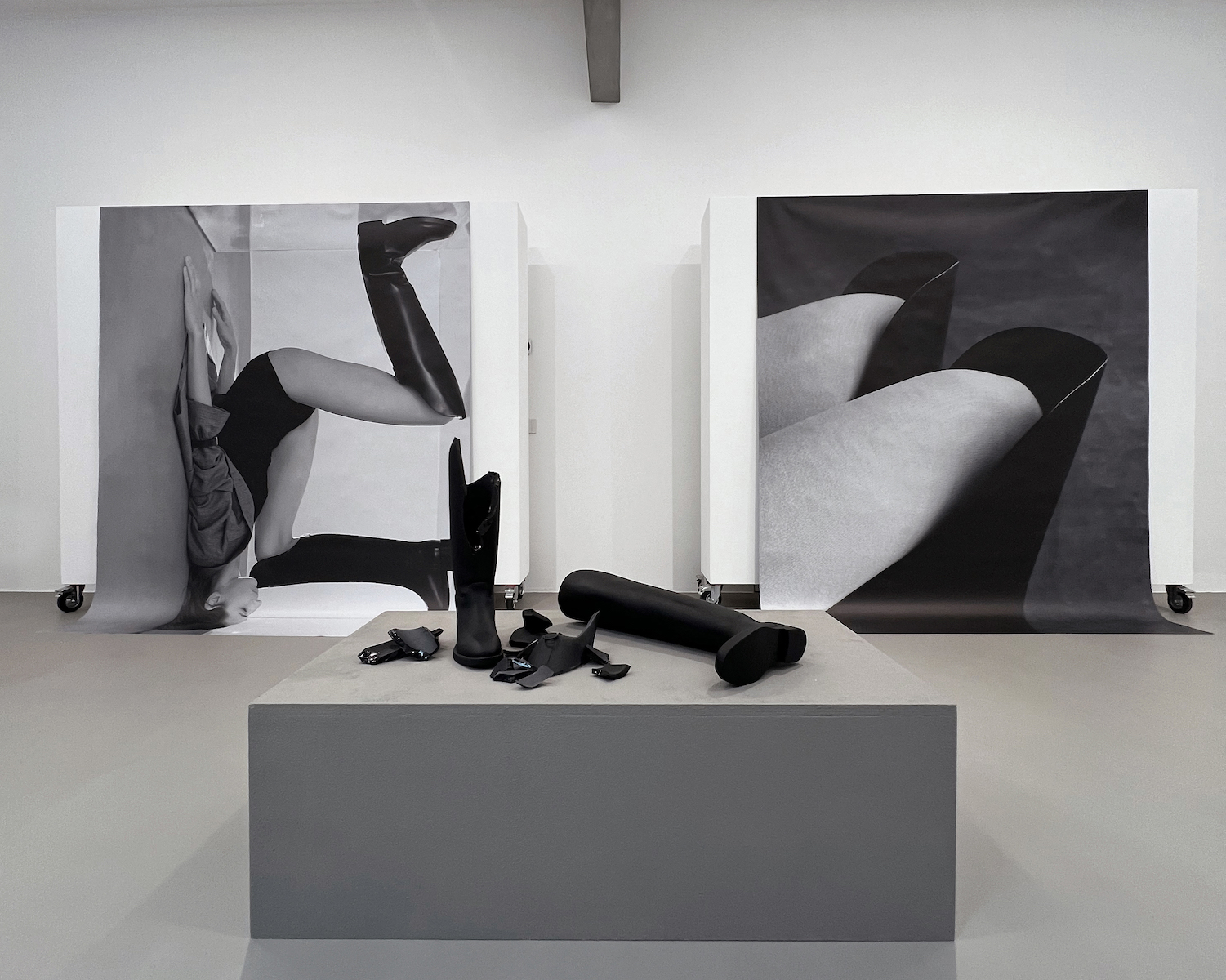 How fashion designer Ilenia Durazzi designed her ‘elegant, rigorous’ Milanese studio – all the way down to the furniture
How fashion designer Ilenia Durazzi designed her ‘elegant, rigorous’ Milanese studio – all the way down to the furnitureIlenia Durazzi of Durazzi Milano tells Wallpaper* the story behind her new Milanese studio, a labour of love built entirely to her exacting design
By Jack Moss